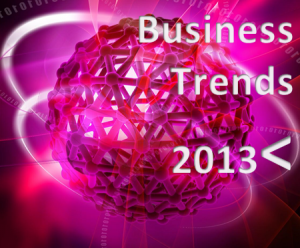 The approach to business growth strategies has changed forever. There is no going back to the “before the GFC” status quo. It’s business-as-unusual, where the new Gangnam-style paradigm rules: fast, opportunistic, seemingly random, and gutsy. However, the growing complexity of inputs and the management models present an ever tightening spiral.
The approach to business growth strategies has changed forever. There is no going back to the “before the GFC” status quo. It’s business-as-unusual, where the new Gangnam-style paradigm rules: fast, opportunistic, seemingly random, and gutsy. However, the growing complexity of inputs and the management models present an ever tightening spiral.
What are the emerging trends to adopt for survival beyond 2013?
Trends are both evolutionary and disruptive in nature. But if embraced early, they offer incomparable opportunities. Best businesses are able not only to prepare but take full advantage of disruptive trends to cross the chasm before anyone else and burn the bridge.
Earlier this year we focused on some of these emerging trends as weak signals: collaboration ecosystems and Non-Negotiable Principles as a blueprint for productivity and agility. Other trends, such as cloud, ‘big data’, or mobility, are informed by the research churned out by the McKinsey machine and other big consulting houses. Our concern with these predictions is that many of the proposed concepts are of gargantuan complexity, negating any potential of real application in any but the largest, most inefficient business.
Our opinion is that to navigate and succeed in the increasingly complex world, businesses need to dramatically simplify their processes and the approach to strategy, or they will drown in the ‘big data’. For this reason, in formulating our 2013 predictions, we include these two non-negotiable principles: communication and understanding.
Here are our top five survival trends for business in 2013 and beyond:
1. Re-design
It’s the new dawn of the Asian Century: Some thirty years ago western companies began the manufacturing exodus in search of price advantage, but today the price advantage has eroded for both sides. While western countries have devastated their own production as well as the innovation muscle, Chinese companies have been building new capabilities which they are now ready to leverage to win global consumers directly.
The dragon hatching season is on. And that’s just China. The South East Asian tiger is also by no means an extinct species.
This is both a great threat and a source of new opportunities especially for Australia: not just the sense of outbound competition but also in terms of defensive strategies on home turf. There is one clear trend: need for re-design. Successful companies will go to the drawing board first to re-design their products, services and business models from scratch to prepare for the new rules of competition. Adapting current products and services by taking out features, service or quality will not do. They must be re-designed around new rules, with new way of thinking.
And here is a thing. Those who respond timely to the Asian century paradigm through innovative design will be able to reap the even greater benefits locally.
2. Collaboration Ecosystems
In the Collaboration 21 series of articles and interviews with some global thought leaders, we described in much detail the new model for collaboration. The key point to note is that the old, linear, “pass-the-baton”, “it’s-not-my-responsibility” model is out. In is the multi-dimensional ecosystem in which partners mobilise mutual resources to co-create a 3-way value: partner-partner-customer. Everyone must win. It is about repeatability.
In the collaboration ecosystems partners actively innovate to add value and have a shared vision and vested interest in co-creating success. This new business model for collaboration is a prototype for disruptive innovation for SMEs and ticket to improved productivity and efficiency for large organisations and universities.
3. Creative Productivity
Productivity is critical to business and economy. Not a new concept, but what makes it a trend is that the current models for productivity, economies of scale and lean, are 50-150 years old and are now failing to yield the desired results. We are on the cusp of the third productivity revolution: creative productivity, i.e. one that doesn’t primarily focus on cost, but on creating value.
There are hidden resources in two areas: technology and employee engagement. Finding and improving technology solutions is the easy part. The real challenge and potential for companies is in harnessing the human factor, both in individual and management productivity.
To release the potential of these resources, businesses must find a way to shorten the distance between Leaders and business strategy and every employee individually. They need communication and coaching solutions to shorten the decision cycle. This agile and high-fidelity decision-making requires what we call ‘strategic democratisation’ of business. Yes, power to the people.
One such approach is via Non-Negotiable Principles. This simple methodology anchors every operational decision, right to the very last employee, in strategy, making the strategic intent transparent and relevant to people’s jobs. By constant practice, the organisation builds operational excellence and capacity for finding creative solutions within the broad guidelines of the clearly defined and communicated company’s Mission.
4. Social Leadership
Vision of a bigger picture and the ability to see patterns beyond short term tactical goals, better and faster than anyone else; is the single most important quality of a Leader.
The new leadership is not about managing or even leading people. This is the age of influence. It is about people “following” you and your brand. It’s about visibility and ‘klout’. Social Media has created a culture and an army of willing followers and promoters. Companies can use it but they can also learn from it to apply the essence of social networks to influencing business culture and the desired behaviours.
SM is about sharing information and interacting with people on the level of their interest and influencing those interests with interesting stories and visual entertainment, and employee-generated social and purposeful content. Tools are available and the camera is rolling.
It takes courage to milk this idle cow. But it is the new role of the Leader to take control of the strategic message and be visible in order to influence creative productivity that builds value.
5. Organic Business
We were wrong in accepting Peter Drucker’s notion that business has two functions. There are three pillars of business: Marketing, Innovation and Service.
Marketing is essential to connect with both the Customers and also with Employees – better and closer than anyone else. To succeed, an organisation must find a unique frequency band to break through the noise. Then, it must innovate 24/7 to keep that frequency open. This will be achieved by organisational rewiring to transform all other functions into Service to support Marketing and Innovation.
Organic organisation is one driven by culture, where all parts of the ‘body’ are connected and support each other in common purpose: survival and well-being. Here, there is no room for ‘independent’ silos of finance, IT, HR, logistics or the concept of budgets that cripple long term performance of the organisation through short term focus.
Leaders must identify the key core competencies that need to be supported through service by all other functions. This will differ from business to business. But the pay-off will be handsome. Organic organisations will have the simplicity required to cope with the accelerating change. An organic organisation is dynamic, adaptive and responsive to change – always focused on the common purpose.
Therefore, having a clear Vision and practical, directional Mission has never been more important as a primary input of a Leader.
We haven’t focused in our ‘predictions’ as much as others on technology. As important as technology is in solving, enabling, simplifying human problems and endeavours, innovation and competitive advantage is never about technology itself. How people are able to weave technology into marketing, innovation and service is how the war will ultimately be won. An organic organisation is able to soften the Edge of Technology to perfectly fit and service the strategy.
Importantly, Organic Organisations are built on two principles mentioned above: communication and understanding.
These five trends are, in our opinion, the key to business survival in and beyond 2013.


